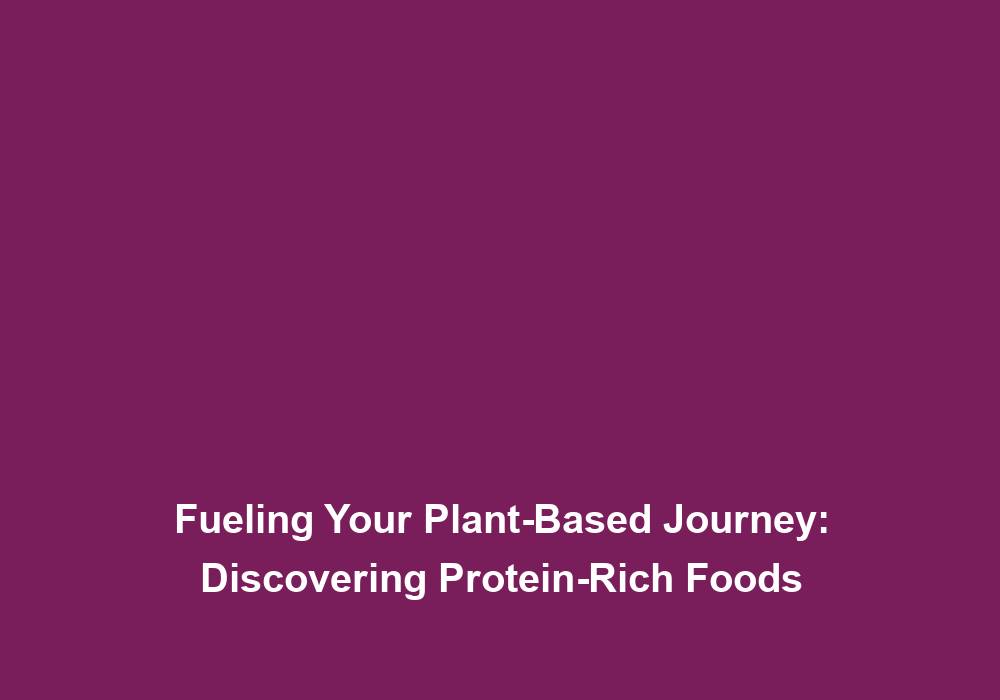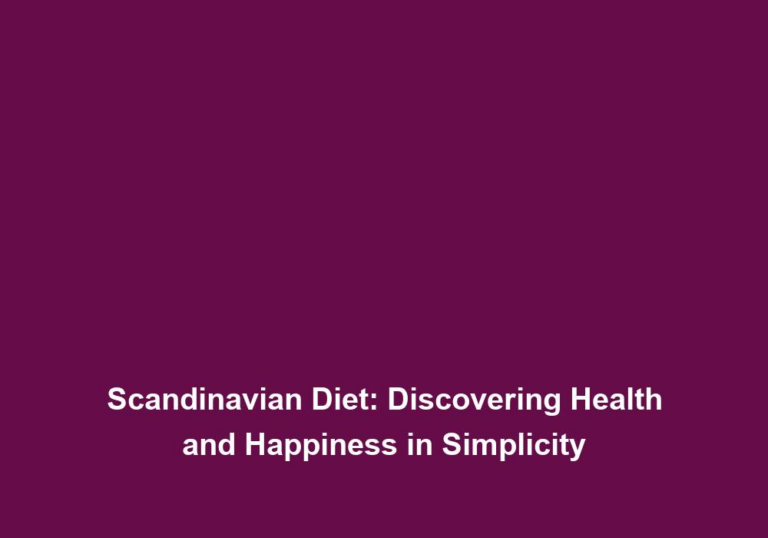Fueling Your Plant-Based Journey: Discovering Protein-Rich Foods
As the popularity of plant-based lifestyles continues to grow, it is crucial to find protein-rich foods that provide the necessary nutrients for a healthy and balanced diet. Contrary to popular belief, plant-based diets can offer ample protein sources without relying on animal products. In this article, we will explore various protein-rich foods suitable for those on a plant-based journey.
Understanding Protein and Its Importance
Proteins are macronutrients composed of amino acids, which serve as the building blocks of our body. They play a crucial role in numerous bodily functions, including muscle development, hormone production, and immune system support. While animal products like meat, fish, and dairy are commonly associated with protein, plant-based alternatives can be equally nourishing.
Plant-based Protein Sources
-
Legumes: Legumes, such as lentils, chickpeas, and black beans, are excellent sources of protein. They not only provide a significant protein boost but are also rich in fiber, iron, and other essential minerals. Incorporating legumes into your diet can help meet your protein needs while promoting digestive health and providing important nutrients.
- Lentils: These small legumes come in various colors and are packed with protein, fiber, and folate. They are versatile and can be used in soups, stews, salads, or even as a meat substitute in burgers.
- Chickpeas: Also known as garbanzo beans, chickpeas are not only a great source of protein but also offer a good amount of dietary fiber and iron. They can be incorporated into curries, hummus, or roasted for a crunchy snack.
- Black Beans: Black beans are rich in protein, fiber, and antioxidants. They can be used in a variety of dishes such as tacos, salads, or blended into a delicious black bean dip.
-
Quinoa: Quinoa is a versatile grain-like seed that contains all nine essential amino acids, making it a complete protein source. It is also high in fiber, magnesium, and antioxidants. Adding quinoa to salads, stir-fries, or as a side dish can enhance your protein intake and provide a nutritious boost to your meals.
- White Quinoa: This is the most common variety of quinoa and has a mild flavor and fluffy texture. It can be used as a base for grain bowls, added to soups, or used as a substitute for rice.
- Red Quinoa: Red quinoa has a slightly nuttier flavor and a chewier texture compared to white quinoa. It works well in salads, pilafs, or as a stuffing for vegetables.
- Black Quinoa: Black quinoa has a slightly sweeter flavor and a crunchier texture. It adds visual interest to dishes and can be used in salads, side dishes, or mixed with other grains.
-
Tofu and Tempeh: Tofu and tempeh, both derived from soybeans, are popular plant-based protein options. Tofu is a versatile ingredient that can be grilled, stir-fried, or blended into sauces. It has a mild taste that absorbs flavors well. Tempeh, on the other hand, has a firmer texture and a slightly nutty flavor. It can be marinated, grilled, or used as a meat substitute in various dishes.
- Firm Tofu: This type of tofu holds its shape well and is perfect for grilling or stir-frying. It can be marinated to add flavor and is often used as a substitute for meat in dishes like stir-fries, tacos, or kebabs.
- Silken Tofu: Silken tofu has a softer texture and is ideal for blending into creamy sauces, dressings, or smoothies. It can also be used in desserts like puddings or cheesecakes.
- Tempeh: Tempeh has a firm texture and a slightly nutty flavor. It can be sliced, marinated, and grilled, or crumbled and used as a ground meat substitute in dishes like tacos, chili, or pasta sauces.
-
Seitan: Seitan, also known as wheat meat or wheat gluten, is a protein-rich food made from gluten, the protein found in wheat. It has a meat-like texture and can be used as a substitute for chicken or beef in recipes. However, individuals with gluten sensitivities should avoid seitan and opt for other plant-based protein sources.
- Seitan Strips: Seitan strips can be marinated and grilled, stir-fried, or used in sandwiches and wraps. They provide a chewy texture and absorb flavors well.
- Seitan Roasts: Seitan roasts are often made by shaping seitan into a roast-like form and baking or simmering it. They can be sliced and served as a centerpiece for holiday meals or sliced and used in sandwiches or salads.
- Seitan Ground Meat Substitute: Seitan can also be crumbled and used as a ground meat substitute in recipes like tacos, chili, or meatballs.
-
Nuts and Seeds: Almonds, walnuts, chia seeds, and hemp seeds are examples of nuts and seeds that provide protein, healthy fats, and a variety of essential nutrients. They can be enjoyed as snacks, added to smoothies, or used as toppings for salads and cereals.
- Almonds: Almonds are not only a good source of protein but also provide healthy fats, fiber, and vitamin E. They can be eaten as a snack, used in baking, or ground into almond butter.
- Walnuts: Walnuts are rich in omega-3 fatty acids, protein, and antioxidants. They can be eaten on their own, added to salads or baked goods, or used as a crunchy topping for oatmeal or yogurt.
- Chia Seeds: Chia seeds are a nutritional powerhouse, offering protein, fiber, omega-3 fatty acids, and antioxidants. They can be added to smoothies, yogurt, oatmeal, or used to make chia pudding.
- Hemp Seeds: Hemp seeds are a complete source of protein, providing all nine essential amino acids. They also offer omega-3 and omega-6 fatty acids, fiber, and minerals. They can be sprinkled on salads, added to smoothies, or used in baking.
-
Soy Products: Besides tofu and tempeh, soy products like edamame, soy milk, and soy yogurt are excellent sources of plant-based protein. They are also rich in calcium and vitamin D, benefiting bone health.
- Edamame: Edamame are young soybeans that are harvested before they fully mature. They can be boiled or steamed and enjoyed as a snack or added to salads, stir-fries, or soups.
- Soy Milk: Soy milk is a popular dairy milk alternative that is fortified with calcium and vitamin D. It can be used in smoothies, cereals, or as a substitute for milk in baking recipes.
- Soy Yogurt: Soy yogurt is a plant-based alternative to dairy yogurt that provides protein, probiotics, and essential nutrients. It can be eaten on its own, used in smoothies, or topped with fruits and granola.
-
Plant-Based Protein Powders: For those who require additional protein or find it challenging to meet their protein needs through whole foods alone, plant-based protein powders can be a convenient option. Pea, brown rice, hemp, and soy protein powders are readily available and can be mixed into smoothies or used in baking.
- Pea Protein Powder: Pea protein powder is derived from yellow split peas and is a great option for those with allergies or sensitivities to soy or dairy. It is easily digestible and can be incorporated into shakes, smoothies, or energy bars.
- Brown Rice Protein Powder: Brown rice protein powder is made from whole grain brown rice and is suitable for those following gluten-free diets. It can be added to shakes, baked goods, or used as a protein boost in oatmeal or yogurt.
- Hemp Protein Powder: Hemp protein powder is derived from hemp seeds and offers a complete amino acid profile. It is rich in omega-3 fatty acids, fiber, and minerals. It can be blended into smoothies, stirred into yogurt, or used in energy balls.
- Soy Protein Powder: Soy protein powder is made from soybeans and provides a high-quality source of plant-based protein. It can be used in shakes, smoothies, or added to recipes like pancakes or muffins.
Tips for Maximizing Protein Absorption
While including protein-rich foods in your plant-based diet is essential, it is equally important to ensure optimal protein absorption. Here are some tips to enhance protein utilization:
-
Combine different protein sources: By combining various plant-based protein sources, you can create a complete amino acid profile. For instance, pairing legumes with grains like brown rice or whole wheat bread forms a complete protein source, ensuring you get all the essential amino acids your body needs.
-
Include vitamin C-rich foods: Vitamin C aids in the absorption of plant-based iron, which is crucial for vegetarians and vegans. Incorporate foods like citrus fruits, bell peppers, and broccoli into your meals to boost iron absorption and maximize the benefits of plant-based proteins.
-
Consume fermented foods: Fermented foods such as sauerkraut, kimchi, and yogurt contain probiotics that support gut health and improve nutrient absorption, including proteins. Including these fermented foods in your diet can enhance the digestion and absorption of plant-based proteins.
-
Moderate caffeine and alcohol intake: Excessive caffeine and alcohol consumption can hinder nutrient absorption. Limiting their intake can optimize protein absorption and overall nutrient utilization, ensuring that your body can efficiently process and utilize the protein you consume.
Conclusion
Discovering protein-rich foods on your plant-based journey is essential for maintaining a healthy and balanced diet. With a wide variety of plant-based protein sources available, including legumes, quinoa, tofu, nuts, and seeds, you can easily meet your protein requirements while enjoying a diverse range of flavors and textures. Remember to incorporate different protein sources to ensure a complete amino acid profile, enhance absorption through proper food combinations, and lead a well-rounded plant-based lifestyle for optimal health and vitality.







